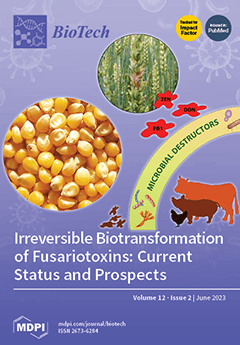Atriplex spp. (saltbush) is known to survive extremely harsh environmental stresses such as salinity and drought. It mitigates such conditions based on specialized physiological and biochemical characteristics. Dehydrin genes (
DHNs) are considered major players in this adaptation. In this study, a
[...] Read more.
Atriplex spp. (saltbush) is known to survive extremely harsh environmental stresses such as salinity and drought. It mitigates such conditions based on specialized physiological and biochemical characteristics. Dehydrin genes (
DHNs) are considered major players in this adaptation. In this study, a novel
DHN gene from Azrak (Jordan) saltbush was characterized along with other
Atriplex species from diverse habitats. Intronless
DHN-expressed sequence tags (495–761 bp) were successfully cloned and sequenced. Saltbush dehydrins contain one S-segment followed by three K-segments: an arrangement called SK3-type. Two substantial insertions were detected including three copies of the K2-segemnet in
A. canescens. New motif variants other than the six-serine standard were evident in the S-segment. AhaDHN1 (
A. halimus) has a cysteine residue (SSCSSS), while AgaDHN1 (
A. gardneri var. utahensis) has an isoleucine residue (SISSSS). In contrast to the conserved K1-segment, both the K2- and K3-segment showed several substitutions, particularly in AnuDHN1 (
A. nummularia). In addition, a parsimony phylogenetic tree based on homologs from related genera was constructed. The phylogenetic tree resolved DHNs for all of the investigated
Atriplex species in a superclade with an 85% bootstrap value. Nonetheless, the DHN isolated from Azraq saltbush was uniquely subclustred with a related genera
Halimione portulacoides. The characterized DHNs revealed tremendous diversification among the
Atriplex species, which opens a new venue for their functional analysis.
Full article






